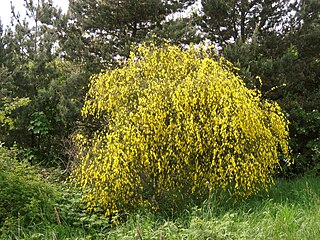
A shrub is a small-to-medium-sized perennial woody plant. Unlike herbaceous plants, shrubs have persistent woody stems above the ground. Shrubs can be either deciduous or evergreen. They are distinguished from trees by their multiple stems and shorter height, less than 6–10 m (20–33 ft) tall. Small shrubs, less than 2 m (6.6 ft) tall are sometimes termed as subshrubs. Many botanical groups have species that are shrubs, and others that are trees and herbaceous plants instead.

Betulaceae, the birch family, includes six genera of deciduous nut-bearing trees and shrubs, including the birches, alders, hazels, hornbeams, hazel-hornbeam, and hop-hornbeams numbering a total of 167 species. They are mostly natives of the temperate Northern Hemisphere, with a few species reaching the Southern Hemisphere in the Andes in South America. Their typical flowers are catkins and often appear before leaves.

Witch-hazels or witch hazels (Hamamelis) are a genus of flowering plants in the family Hamamelidaceae, with three species in North America, and one each in Japan (H. japonica) and China (H. mollis). The North American species are occasionally called winterbloom.

Hazels are plants of the genus Corylus of deciduous trees and large shrubs native to the temperate Northern Hemisphere. The genus is usually placed in the birch family Betulaceae, though some botanists split the hazels into a separate family Corylaceae. The fruit of the hazel is the hazelnut.
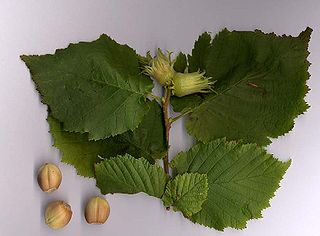
Corylus avellana, the common hazel, is a species of flowering plant in the birch family Betulaceae, native to Europe and Western Asia. It is an important component of the hedgerows that were, historically, used as property and field boundaries in lowland England. The wood was traditionally grown as coppice, with the poles cut being used for wattle-and-daub building, and agricultural fencing.

The hazel grouse, sometimes called the hazel hen, is one of the smaller members of the grouse family of birds. It is a sedentary species, breeding across the Palearctic as far east as Hokkaido, and as far west as eastern and central Europe, in dense, damp, mixed coniferous woodland, preferably with some spruce. The bird is sometimes referred to as "rabchick" by early 20th century English speaking travellers to Russia.

Corylus maxima, the filbert, is a species of hazel in the birch family Betulaceae, native to southeastern Europe and southwestern Asia, from the Balkans to Ordu in Turkey.

A catkin or ament is a slim, cylindrical flower cluster, with inconspicuous or no petals, usually wind-pollinated (anemophilous) but sometimes insect-pollinated. They contain many, usually unisexual flowers, arranged closely along a central stem that is often drooping. They are found in many plant families, including Betulaceae, Fagaceae, Moraceae, and Salicaceae.

Corylus colurna, the Turkish hazel or Turkish filbert, is a deciduous tree native to southeast Europe and southwest Asia, from the Balkans through northern Turkey to northern Iran. It is also found growing wild in the forests of Western Himalayan range in the north Indian state of Himachal Pradesh particularly in the temperate regions of districts of Kullu, Shimla, Kinnaur district and Chamba district.

Corylus cornuta, the beaked hazelnut, is a deciduous shrubby hazel with two subspecies found throughout most of North America.

The Hazel-Atlas Glass Company was a large producer of machine-molded glass containers headquartered in Wheeling, West Virginia. It was founded in 1902 in Washington, Pennsylvania, as the merger of four companies:

The Polly Hill Arboretum includes 8 ha under cultivation, with an additional 16 ha of native woodland, located on Martha's Vineyard at 809 State Road, West Tisbury, Massachusetts, United States. It has been developed since 1958 by the horticulturist Polly Hill, and was listed on the National Register of Historic Places in 2015.

Hoyt Arboretum is a public park in Portland, Oregon, which is part of the complex of parks collectively known as Washington Park. The 189-acre (76 ha) arboretum is located atop a ridge in the Tualatin Mountains two miles (3.2 km) west of downtown Portland. Hoyt has 12 miles of hiking trails, two miles of accessible paved trails, and is open free to the public all year. About 350,000 visitors per year visit the arboretum.

The Sir Harold Hillier Gardens is an arboretum comprising 72 hectares accommodating over 42,000 trees and shrubs in about 12,000 taxa, notably a collection of oaks, camellia, magnolia and rhododendron.
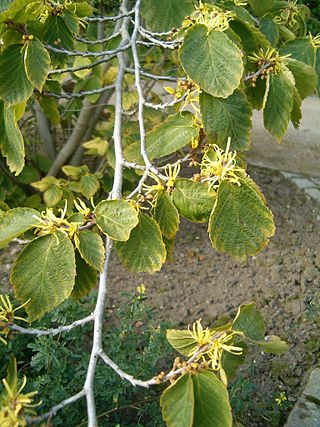
Hamamelis virginiana, known as witch-hazel, common witch-hazel, American witch-hazel and beadwood, is a species of flowering shrub native to eastern North America, from Nova Scotia west to Minnesota, and south to central Florida to eastern Texas.

Hamamelis vernalis, the Ozark witchhazel is a species of flowering plant in the witch-hazel family Hamamelidaceae, native to the Ozark Plateau in central North America, in Missouri, Oklahoma, and Arkansas. It is a large deciduous shrub growing to 4 m (13 ft) tall.
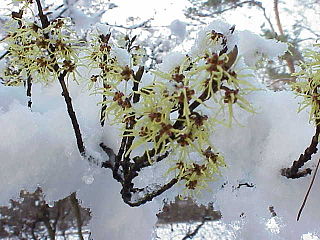
Hamamelis mollis, also known as Chinese witch hazel, is a species of flowering plant in the witch hazel family Hamamelidaceae, native to central and eastern China, in Anhui, Guangxi, Hubei, Hunan, Jiangxi, Sichuan, and Zhejiang.
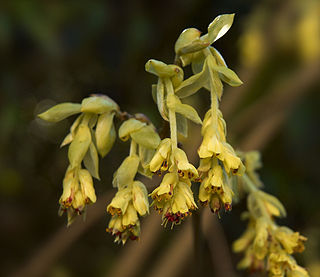
Corylopsis pauciflora, the buttercup witch hazel or winter hazel, is a species of flowering plant in the family Hamamelidaceae, native to Taiwan and Japan. It is a deciduous, spreading shrub growing to 1.5 m tall by 2.5 m wide. It produces masses of pale yellow flowers in pendent racemes in early spring, followed by leaves opening bronze and turning to rich green. It is cultivated in gardens and parks in temperate regions.

Dolphin Tale 2 is a 2014 American family film written and directed by Charles Martin Smith as the sequel to his 2011 film Dolphin Tale which in-turn was based on the true story about a rescued bottlenose dolphin named Winter who made her final on-screen appearance in this film before her death in November 2021. In addition to Winter, most of the cast from the first film also reprise their roles including Harry Connick Jr., Ashley Judd, Nathan Gamble, Cozi Zuehlsdorff, Kris Kristofferson, Morgan Freeman, Austin Stowell, Tom Nowicki, Austin Highsmith, Betsy Landin and Juliana Harkavy while Hope made her film debut. It was released on September 12, 2014, and tells the story of another dolphin at the Clearwater Marine Aquarium named "Hope". After Winter's elderly companion and surrogate mother, Panama, dies, Winter's future is in jeopardy, unless Sawyer, Clay, Hazel, and the rest of the team can find a new companion for her. The film received generally mixed to positive reviews from critics and grossed $57.8 million.

Cuscuta coryli, synonym Grammica coryli, common name hazel dodder, is a perennial plant in the Cuscutaceae family native to North America.




















